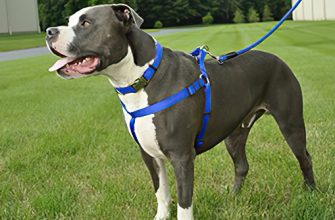A dog harness is a useful and convenient piece of equipment for dogs. It can serve as an alternative for a conventional collar, as it provides better control over a pet while reducing the pressure on the neck and throat. Besides, harnesses are indispensable during travel. Finally, some harnesses look really great. They come in different forms, colors, and designs. To make the most of a harness one needs to know how to choose the best option and how to use it. Our step-by-step guide contains useful tips and instructions on using dog harnesses.
Table of Contents:
How to Put on a Dog Harness: a Simple Instruction
How to Choose the Type of a Dog Harness
How to Fit a Dog Harness
Frequently Asked Questions
To Sum It Up
How to Put on a Dog Harness: a Simple Instruction
We’ve prepared a detailed guide for dog owners, who have no experience in using dog harnesses. Though the procedure can seem pretty simple, there are some important things to consider. If your dog has never worn a harness before, we recommend to follow the instruction on how to put on a dog harness without missing any steps to make harness-training easy and stress-free.
- Unpack a new harness and put it on the floor or near your pup’s food dish or lair. Let your dog sniff and touch it (but keep an eye on it to prevent chewing!) A dog needs to get familiar with the new object before trying it on.
- Use positive reinforcement by placing treats near the harness.
- Continue throwing treats toward the harness occasionally to strengthen positive associations.
- Make sure your canine has a positive view of the harness. If so, try to introduce the harness to it.
- Slip the harness over the pet’s head quickly. After that, encourage it with stroking and treats. Take it off and put on several times. Give treats every time.
- If you use a step-in option type of a harness, put in on the floor and make your pup step in it. Reward the dog with a treat, and then repeat several times.
- After 10 or so successful attempts, try to place the harness on the dog’s body. Calm it down by stroking and giving treats.
- Fasten the harness with Velcros or clips quickly. Let your dog stay in the harness for some time.
- Repeat this step several times. If your pup looks worried, try to shift its focus of attention on something else, for example, chewing a bone.
- Let your canine walk around the home in the harness for a while to get used to the new sensations. You may repeat this exercise several days in a row.
- Once you see that your dog feels comfortable wearing the harness, attach a leash and make your first outdoor walk.
Depending on the dog’s temper, harness training can take from a couple of days to a couple of weeks. Don’t try to facilitate the process if you see that your pup is not ready for walking in a harness yet. Your patience will be rewarded soon.
(Video) How to Put on a Dog Harness: a Step-by-Step
How to Choose the Type of a Dog Harness
There are several types of dog harnesses, depending on their design. They are different in the way they are put on and secured. The most popular types are the following:
- standard harnesses;
- step-in harnesses;
- overhead harnesses;
- front clip harnesses.
A key tip I’ll give you is always to try and find the top of the harness. Almost all harnesses, except for the Halti front leader, typically have the buckle where the leash attaches at the top on the dog’s back.
Choosing the best type depends on the dog’s body/head shape, size, build, physical health, and temper. For example, if a dog has problems with its neck, you’d better opt for chest-cross front clop or step-in harnesses to minimize the pressure on the neck, especially if you are going to put on a dog harness on a puppy. Overhead harnesses are good for well-trained pups, while nervous dogs can be scared by the straps that are slipped over the head.
Standard Harnesses
This is a classic dog harness made of nylon straps that are wrapped around the neck and the chest. The two loops meet on the back and are attached to each other with another short strap. A D-ring for attaching a leash is also placed on the back (between the shoulders). Fitting a standard harness is pretty simple. You need to measure the neck girth and chest girth of your pup. Choose the size relying on the size chart, which can be found on the manufacturer’s site. Besides, the harnesses of this type are fully adjustable, so fitting them is not a problem. To check the fitting try to place your fingers between the straps and the pup’s body. There must be enough space for two fingers.
Step-In Harnesses
A step-in harness is the one that comes with holes for front legs. Once your dog steps in the holes, you can quickly fasten it on the shoulders. They are good for well-trained dogs that understand what they should do. Exactly like standard harnesses, the step-in options are fully adjustable and come in several sizes.
Fitting a step-in harness is as easy as fitting a standard harness. You must be able to place two fingers between the straps and the body of your dog. It’s recommended to check the fit from time to time: if it becomes too loose, your tricky dog can escape.
Overhead Harnesses
This category, probably, boasts the largest diversity. They come in a variety of styles and colors: padded and nylon, V-shaped and straight straps, with Velcro fastenings and buckles, and so on. The main distinctive feature of overhead harnesses is a loop that is slipped over the head. A dog puts its head in this loop, after which you wrap a chest strap around its body and fasten it. By the way, overhead harnesses are similar to life vests in terms of their design, so if you are planning water activities in the future, you won’t have to retrain the dog. Overhead harnesses (they are sometimes referred to as jackets) are easy to adjust. Before buying a harness, measure your dog’s neck and chest girth and use the manufacturer’s size chart.
Front Clip Harnesses
Front clip harnesses are designed for large, strong or very stubborn dogs that are hard to control. They can come in a variety of types, but the main idea is the availability of another D-ring on the chest and a double-ended leash. The leash is attached at two points simultaneously – on the back and on the chest, making it easier to control a dog. An extra control point lets you off-balance your pooch when needed. Front clips harnesses are often made of durable nylon straps that are fully adjustable. You can use the same method of two fingers to fit the harness properly.
How to Fit a Dog Harness
We have already touched upon the question of fitting a dog harness in the previous section. Let’s summarize the information once again. Here are the main things to consider.
Sizing
Choosing a proper size is crucial, as an ill-sized harness is uncomfortable and unreliable. That is why you need to measure your pup before purchasing anything. First, measure its girth (the widest place of the chest). It is easy to find, as it is located right behind the front legs. Second, measure the chest itself. Finally, measure the neck girth at its widest point. After that, match your results with the size chart offered by the manufacturer of the harness selected.
Fitting
A harness must be tight enough to prevent dog escaping. At the same time, a dog must not be hampered by it. If you are not sure whether the harness fits well, use the rule of two fingers. If you are able to place two fingers under the strap, it fits properly.
Placing the Straps
Always check the straps for twists before putting on a harness. They must be absolutely flat. Depending on the harness design, there can be two or three straps. Typically, they are wrapped around the neck and the chest. But some harnesses feature chest straps as well.
Adjusting
Most harnesses are easy to adjust. Find a plastic adjuster and thread the strap through it to regulate its tightness. Don’t forget to check the fitting regularly. This is especially important for puppies (they tend to grow up quickly) and active dogs, which can lose weight after intensive training.
Frequently Asked Questions
Dog owners often ask questions about dog harnesses, their features, and benefits. We’ve gathered some popular questions in our FAQ section.
Q: A Harness vs a Collar: What is Better?
A: Both collars and harnesses have some pros and cons. A harness is more comfortable and less traumatic for the neck and throat. Also, it provides better control over stubborn pups. A collar, in its turn, can be worn all the time. There’s no need to take it off after every walk. Also, you can attach an ID tag to it.
Q: Do Harnesses Prevent Dog Pulling?
A: No, they don’t. To prevent pulling you’d better opt for a training collar. A harness just helps to distribute the pressure more evenly.
Q: When Should I Start Training?
A: The earlier the better. Specialists recommend to start training when your dog is a puppy. That said, it’s not impossible to harness-train an adult dog, but it will take more time and effort.
Q: What Type of Harness Should I Buy?
A: There’s no single answer to this question. Overhead harnesses are the most popular ones, but some dogs are stressed with the need of putting the head in the hole. In this case, you may want to choose a classic or step-in harness.
Q: Can my dog wear a harness?
A: Yes, surely. All healthy dogs of all breeds can wear harnesses. However, it’s important to choose the right type and size of the harness to provide maximum effectiveness and security. A harness is a good alternative for a traditional collar for several reasons. Firstly, it doesn’t create strong pressure on the throat, so there is no risk of choking. Secondly, it is more escape-proof if compared to a collar. Finally, some harnesses allow attaching two leashes and provide better control over large and strong pooches.
Q: What Is The Most Common Type Of Harness?
A: The most popular type of harnesses for dogs are back-clip harnesses. Such a model features a D-ring attachment right on the back. The harness type is the most common among dog owners thanks to the ease of use and comfortability for dogs. You attach the leash quite far from the trachea on the harness back. Such a system makes the harness suitable for small dogs with gentle throats, too. Besides, the leash won’t get tangled around the animal’s legs while walking him. However, there are a couple of points to consider before choosing this widespread type of harness for your dog. If your little friend has the habit of lunging, be aware that the back-clips don’t discourage pulling. Additionally, unlike front-clip harnesses, back-clip ones don’t provide a directional correction.
To Sum It Up
No matter what type of dog harness you opt for, make sure your pup feels comfortable in it. Check how do you put a harness on a dog? Don’t you cause pain or discomfort to your pup? Don’t try to facilitate the training – be patient and persistent. With the right approach, a harness will become a useful assistant in the outdoor adventures of your dog and you.




/08/unnamed-1.jpg)
/07/logo2x-1.png)

/09/can-dogs-get-sick-from-eating-cat-poop3-100x100.jpg)




oldest
<a